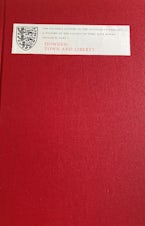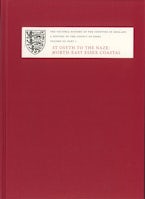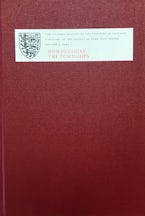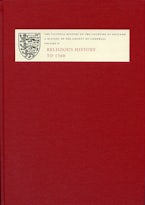
→
Recommend to library
Title Details
320 Pages
30.5 x 20.8 cm
55 b/w, 33 line illus.
Series: Victoria County History
Imprint: Victoria County History
A History of the County of Stafford
XII: Tamworth and Drayton Bassett
- Description
- Reviews
Authoritative and comprehensive history of the town of Tamworth and its environs.
In the centre of a parish with several townships, Tamworth was important for the rulers of pre-Viking Mercia and became a burh in 913 under Æthelflæd, "lady of the Mercians", who may also have installed relics of St Edith in the church there. Although a castle was built after the Norman Conquest, its lords did not control the town, which became a corporation under Elizabeth I and is now the head of a district council. Throughout its history Tamworth has functioned as a market centre, with some cloth-working and paper-making, although cotton mills, opened by Robert Peel (the later Prime Minster's father), just outside the town in the 1790s were soon moved to a canal junction to the south in Fazeley, where tape-making survived (as also in the town) until the late twentieth century.
Deposits of coal and clay exploited from the nineteenth century resulted in mining villages at Glascote and Wilnecote inthe eastern half of the parish, which lay in Warwickshire, as did half the town until transferred to Staffordshire in 1890. The Warwickshire part of the parish was added in 1965 in connection with the decision to take in a Birmingham overspill population, which together with private developments created vast housing estates, the population of "greater Tamworth" more than doubling by the early 21st century. The volume also includes the adjoining parish of Drayton Bassett, which had close links with the town and where Peel built a mansion house, demolished in the earlier twentieth century: its site is now part of a major amusement park.
In the centre of a parish with several townships, Tamworth was important for the rulers of pre-Viking Mercia and became a burh in 913 under Æthelflæd, "lady of the Mercians", who may also have installed relics of St Edith in the church there. Although a castle was built after the Norman Conquest, its lords did not control the town, which became a corporation under Elizabeth I and is now the head of a district council. Throughout its history Tamworth has functioned as a market centre, with some cloth-working and paper-making, although cotton mills, opened by Robert Peel (the later Prime Minster's father), just outside the town in the 1790s were soon moved to a canal junction to the south in Fazeley, where tape-making survived (as also in the town) until the late twentieth century.
Deposits of coal and clay exploited from the nineteenth century resulted in mining villages at Glascote and Wilnecote inthe eastern half of the parish, which lay in Warwickshire, as did half the town until transferred to Staffordshire in 1890. The Warwickshire part of the parish was added in 1965 in connection with the decision to take in a Birmingham overspill population, which together with private developments created vast housing estates, the population of "greater Tamworth" more than doubling by the early 21st century. The volume also includes the adjoining parish of Drayton Bassett, which had close links with the town and where Peel built a mansion house, demolished in the earlier twentieth century: its site is now part of a major amusement park.
"This is volume XII in the VCH's series on Staffordshire and the fifteenth published in the intended coverage. The enlightened interest and continuing sponsorship of Staffordshire County Council and Keele University that have brought the series so far place us greatly in their debt. But the notable landmark of this volume is its being the last of its diligent and resourceful editor, Nigel Tringham. It is a splendid end to a forty-year career." Medieval Settlement Research Group
"This publication is also noteworthy as probably the last VCH volume to be researched and written by a single editor. It is a tour de force and a tribute to professionalism and expertise built up over decades. Making sense of this patchwork of landownership and administration could have defeated other writers. The wealth of resources in footnotes and references is invaluable, while excellent maps add much to the volume's usefulness. A long list of acknowledgments testifies to collaborative consultation with other historians but, indisputably, this volume is the editor's own: an admirable and impressive conclusion to a VCH career of over forty years" Local Historian
"The website of The Victoria County History claims that the publication series 'is one of the world's longest-running research projects, exploring England's rich local history'.1 Managed by the University of London's Institute of Historical Research, since 1899 large numbers of detailed, well-researched and descriptive 'Red Books' have provided starting points for anyone interested in local history. The success of the series depends on alliances of university history departments, county archives and independent scholars. Staffordshire is one county where this coalition has been parti
cularly successful. Since 1993, a partnership between Staffordshire County Council and Keele University has resulted in the publication of five volumes researched and authored by Nigel Tringham. This volume covers Tamworth (the name comes from the river - the Tame - an Indo-European word meaning 'flow') and Drayton Bassett. There are also sections on individual settlements including Glascote, Fazeley, Hopwas and Wilnecote, each of which has a distinctive history.
The book's themes are similar to those in other county histories. Each area contains an introduction (including population and communications and previous histories, where relevant) and sections on settlement, landownership, economic history, local government, social history and religious history. In Tamworth's case, the castle, the town's most historic building, alongside St Editha's church, has a segment to itself. Tamworth became an administrative centre under the Anglo-Saxon kingdom of Mercia and in 913, under Queen Æthelflæd, a burh or fortified settlement. The castle was built after the Norman Conquest and Tamworth developed as a market town.
Canal development enabled Robert Peel the elder to turn Fazeley into a cotton manufacturing centre in the 1790s. His son, also called Robert, the MP for Tamworth and future prime minister, built Drayton Bassett mansion in 1835 (largely demolished in 1926). The site became an amusement park in 1950, now known as Drayton Manor Park. Glascote and Wilnecote emerged as centres for extracting coal and clay in the early nineteenth century and in the twentieth century, the Tamworth area became home to the Reliant Motor Company, which manufactured the four-wheel Scimitar sports car (1964) and three-wheel Robin (1973). Tamworth's skyline is dominated by six tower blocks which are physical manifestations of population growth in the 1960s to house people from Birmingham. Despite redevelopment, Tamworth retains a medieval, early modern and nineteenth-century core, with many fascinating buildings, but physically much of the townscape contains retail outlets and council and private estates built since the late twentieth century.
There are many human stories. One relates to Bruno Hamel, a refugee from Revolutionary France in the 1790s who established a dynasty of artists, manufacturers and mayors. The Notes on Sources (xiv- xvii) is especially helpful to the researcher. This scholarly, fascinating, well-illustrated and clearly written publication is an important contribution to local history." Malcolm Dick University of Birmingham, Midland History
Hardcover
9781904356523
March 2021
$140.00 / £95.00
Title Details
320 Pages
3.05 x 2.08 cm
55 b/w, 33 line illus.
Series: Victoria County History
Imprint: Victoria County History






![A History of the County of Stafford [13 Volume Set]](https://boydell-brewer-uk.imgix.net/missing-cover.png)









